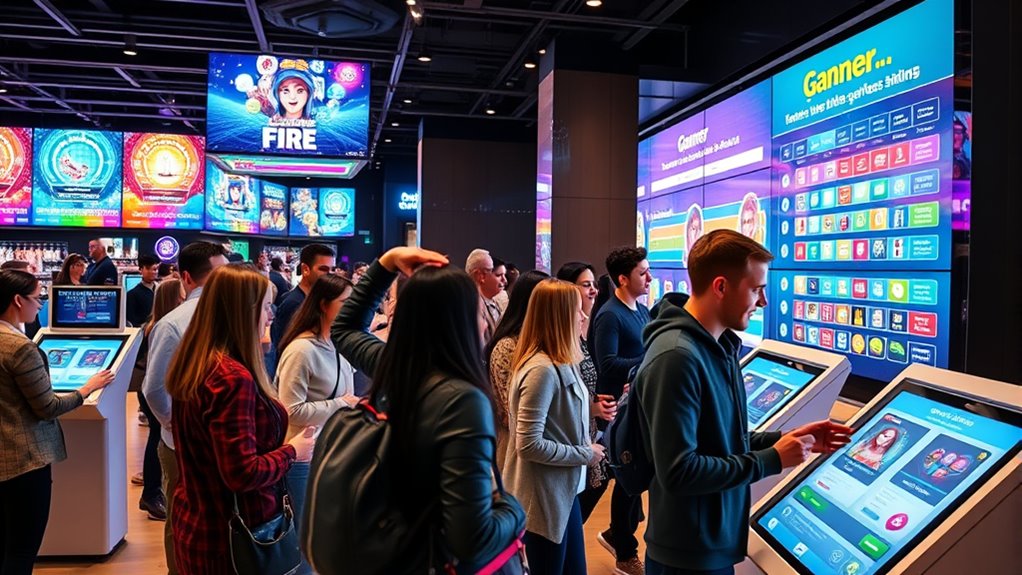To leverage gamification for customer engagement, you should incorporate clear reward systems like points, badges, or discounts that motivate ongoing participation. Create opportunities through challenges, quizzes, and fun activities that encourage active involvement. Tailor rewards to different audience motivations and introduce new challenges to keep the experience fresh. By fostering a dynamic environment, you’ll turn casual users into loyal advocates. Keep exploring how to transform interactions into meaningful experiences for your customers.
Key Takeaways
- Implement clear reward systems like points, badges, and discounts to motivate ongoing customer engagement.
- Design attainable yet challenging activities, such as quizzes and challenges, to encourage active participation.
- Personalize rewards and incorporate social recognition to deepen connections with diverse customer segments.
- Introduce evolving challenges and milestones to maintain interest and promote long-term involvement.
- Use leaderboards and progress tracking to foster healthy competition and reinforce customer loyalty.

In today’s competitive market, businesses are constantly searching for innovative ways to capture and retain customer attention. One effective strategy is implementing gamification, which taps into the natural human desire for challenge, achievement, and recognition. At the core of successful gamification is the thoughtful design of reward systems that motivate users and encourage ongoing engagement. When customers see clear incentives—such as points, badges, or discounts—they’re more inclined to participate actively. Reward systems act as immediate gratification, reinforcing desired behaviors and making interactions with your brand more enjoyable. By integrating these rewards seamlessly into your platform or service, you foster a sense of accomplishment that keeps users coming back for more. Incorporating elements like Eye Patch Benefits can also enhance user engagement by providing tangible results that motivate continued participation.
User participation is the lifeblood of any gamified experience. The more involved your customers feel, the stronger their connection to your brand becomes. You want to create opportunities for genuine interaction, not just passive consumption. This can mean challenges, quizzes, or tasks that users complete to earn points or access new features. When users feel that their actions directly impact their experience and rewards, they become more invested. It’s essential to design these activities in a way that feels attainable yet challenging, striking a balance that pushes users without causing frustration. As participation increases, so does the likelihood of building a loyal community around your brand.
Encouraging user participation through gamification also involves understanding what motivates your audience. Some customers respond well to competitive elements like leaderboards, where they can compare their progress with others. Others might value personalized rewards or social recognition, such as sharing achievements on social media. By tailoring your reward systems to suit different motivations, you deepen engagement and foster a sense of belonging. It’s also vital to keep the experience fresh and evolving—introducing new challenges, rewards, and milestones to sustain interest over time.
Ultimately, leveraging reward systems and user participation creates a dynamic environment that transforms routine interactions into meaningful experiences. When customers find your brand fun, rewarding, and engaging, they’re more likely to become loyal advocates. Gamification isn’t just about adding game-like features; it’s about understanding human psychology and designing interactions that inspire ongoing involvement. By focusing on rewarding active participation, you turn casual users into enthusiastic supporters who enjoy engaging with your brand and spreading positive word-of-mouth. This approach not only boosts customer satisfaction but also drives long-term business growth.
Frequently Asked Questions
How to Measure the ROI of Gamification Initiatives?
You measure ROI of gamification initiatives by tracking customer engagement metrics like increased time spent, repeat visits, and conversions. Use data analytics to analyze pre- and post-implementation data, identifying improvements in customer loyalty and sales. Focus on KPIs such as active users, participation rates, and revenue growth. By quantifying these outcomes, you can effectively evaluate how gamification drives business results and optimizes your investment.
What Are Common Pitfalls When Implementing Gamification Strategies?
You might face pitfalls like reward saturation, where users become uninterested when rewards lose value, and user fatigue, leading to disengagement over time. To avoid these, guarantee rewards stay meaningful and fresh, and design variety into your gamification strategies. Keep track of engagement levels regularly, and be ready to adapt your approach. By doing so, you maintain user interest and prevent burnout, maximizing your campaign’s effectiveness.
How Can Small Businesses Effectively Use Gamification?
You can effectively use gamification by focusing on customer engagement through simple reward systems. Small businesses should start with achievable goals, like loyalty points or badges, to motivate participation. Investigate what truly motivates your customers, then tailor your rewards accordingly. By making interactions fun and rewarding, you boost loyalty and encourage repeat business. Remember, authentic engagement matters more than complex games, so keep it straightforward and customer-centric.
What Are Ethical Considerations in Gamifying Customer Interactions?
You should consider privacy concerns and cultural sensitivity when gamifying customer interactions. Guarantee you protect customer data and be transparent about data usage to avoid privacy issues. Respect diverse cultural backgrounds by designing inclusive, culturally aware challenges and rewards. This approach fosters trust and engagement, preventing potential misunderstandings or offense. Balancing fun with ethical responsibility helps create a positive experience that respects all customers’ values and rights.
How Does Gamification Influence Long-Term Customer Loyalty?
Gamification greatly boosts your customer engagement, ultimately fostering brand loyalty. When you incorporate game-like elements, you motivate customers to return, rewarding their loyalty with fun and familiarity. This consistent connection deepens their emotional attachment to your brand, encouraging ongoing participation. By making interactions interactive and enjoyable, you turn fleeting customers into loyal advocates who keep coming back, strengthening your long-term relationship and ensuring sustained success.
Conclusion
By incorporating gamification, you can boost customer engagement substantially—studies show that 70% of customers feel more connected to brands that use game-like elements. This approach turns routine interactions into exciting experiences, encouraging loyalty and repeat business. So, don’t underestimate the power of play; it’s not just fun, but a strategic tool to deepen customer relationships. Embrace gamification today, and watch your engagement levels soar as your customers become more invested in your brand.










